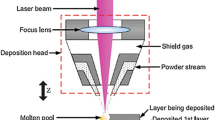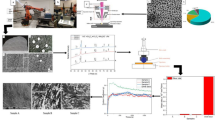Abstract
The upgrade of the anti-wear property of steel base-plate for soil-working tools was done by depositing chromium–vanadium carbide deposits in situ via powder imbuement of FeCrV15 powder through laser cladding. The created specimens were exposed to microstructural examinations, microhardness, and wear test. The impact of introducing additional chromium into the deposit was likewise explored on the fabricated coatings' microstructure, hardness, and anti-wear properties. It was seen that the additional chromium option expanded the austenitic iron development, diminished the concentration of the precipitated carbides, and brought about a lot bigger grain arrangement of the formed phases, which brought down the grain boundary density prompting a decreased hardness of 553 HV for FeCrV15 +Cr, contrasted with 835 HV for FeCrV15, which are fundamentally higher than 170 HV for the steel substrate. The outcome are deposits free from defects with a solid metallurgical attachment to the substrate. The FeCrV15 deposits showed a better wear-resistant capacity multiple times higher than FeCrV15 + Cr. This incredible wear opposition is accredited to the better formation of VC–Cr3C2 particles and improved grain boundary density because of the grain refinement of FeCrV15 deposits, which are vehemently strengthened in the iron base matrix.











Similar content being viewed by others
Data availability
Not applicable.
Code availability
Not applicable.
References
J. Singh, S.S. Chatha, B.S. Sidhu, Abrasive wear behavior of newly developed weld overlaid tillage tools in laboratory and in actual field conditions. J. Manuf. Process. 55, 143–152 (2020)
B. Aramide et al., Improving the durability of tillage tools through surface modification—a review. Int. J. Adv. Manuf. Technol. 116(1), 83–98 (2021)
J.E. Fernández et al., Materials selection to excavator teeth in mining industry. Wear 250(1), 11–18 (2001)
P. Hrabě, M. Müller, V. Hadač, Evaluation of techniques for ploughshare lifetime increase. Res. Agric. Eng. 61(2), 72–79 (2015)
A. Natsis, G. Papadakis, J. Pitsilis, The influence of soil type, soil water and share sharpness of a mouldboard plough on energy consumption, rate of work and tillage quality. J. Agric. Eng. Res. 72(2), 171–176 (1999)
M. Scholl, R. Devanathan, P. Clayton, Abrasive and dry sliding wear resistance of Fe-Mo-Ni-Si and Fe-Mo-Ni-Si-C weld hardfacing alloys. Wear 135(2), 355–368 (1990)
A.S. Kang, J.S. Grewal, G.S. Cheema, Effect of thermal spray coatings on wear behavior of high tensile steel applicable for tiller blades. Mater Today 4(2), 95–103 (2017)
P. Hrabě, M. Müller, Research of overlays influence on ploughshare lifetime. Res. Agric. Eng. 59(4), 147–152 (2013)
Z. Horvat et al., Influence of ploughshare surface layers on ploughing efficiency. Metal 57(1–2), 125–127 (2018)
B.P. Aramide et al., Influence of vanadium-chromium carbide on the microstructure of reinforced FeCrV15 hardfacing during laser cladding deposit. J. Mater. Eng. Perform. 31, 514–523 (2021)
K. Günther, J.P. Bergmann, Influencing microstructure of vanadium carbide reinforced FeCrVC hardfacing during gas metal Arc welding. Metals 10(10), 1345 (2020)
B. P. Aramide et al., Addition of chromium and its effect on the microstructure and mechanical properties of laser-coated high carbon ferrochrome alloy on mild steel. Research Square (2021)
B. Aramide et al., Influence of extra chromium addition on the microstructure, hardness, and corrosion behaviour of high carbon ferrochrome FeCrV15 deposited through laser cladding on steel base-plate for tillage application. Surf. Topogr. Metrol. Prop. 9(4), 045029 (2021)
A. Alamr, D.F. Bahr, M. Jacroux, Effects of alloy and solution chemistry on the fracture of passive films on austenitic stainless steel. Corros. Sci. 48(4), 925–936 (2006)
R.G. Bayer, Wear analysis for engineers. Ind. Lubr. Tribol. 60, 4 (2008)
Q. Wu et al., Microstructure and wear behavior of laser cladding VC–Cr7C3 ceramic coating on steel substrate. Mater. Des. 49, 10–18 (2013)
E. Kocaman et al., The influence of chromium content on wear and corrosion behavior of surface alloyed steel with Fe(16–x)Crx(B, C)4 electrode. Int. J. Eng. Sci. Technol. 24(2), 533–542 (2021)
B. Venkatesh, K. Sriker, V.S.V. Prabhakar, Wear characteristics of hardfacing alloys: state-of-the-art. Proced. Mater. Sci. 10, 527–532 (2015)
K.D. Ralston, N. Birbilis, Effect of grain size on corrosion: a review. Corrosion 66, 075005-075005–075013 (2010)
B. Du et al., Laser cladding of in situ TiB2/Fe composite coating on steel. Appl. Surf. Sci. 254(20), 6489–6494 (2008)
M. Darabara, G.D. Papadimitriou, L. Bourithis, Tribological evaluation of Fe–B–TiB2 metal matrix composites. Surf. Coat. Technol. 202(2), 246–253 (2007)
Acknowledgement
The authors acknowledge the financial support from Tshwane University of Technology (TUT), Pretoria, South Africa, without which this work would not have been possible. The authors appreciate the effort of Samuel Skhosane, Paul Lekoadi, and Thembi Dlamini of the National Laser Centre (Laser Enabled Manufacturing Resource Group), Council for Scientific and Industrial Research (CSIR) for their assistance with the machine.
Funding
This work is funded by the Tshwane University of Technology, Pretoria, South Africa.
Author information
Authors and Affiliations
Contributions
BA conceptualized the idea, formulated the research goals, and aims, developed the design methodology and the creation of models, designed the study, and wrote the original draft of the manuscript. RS supervised and assisted with the provision of study materials, editing, and reviewing the original draft of the manuscript. PP supervised, taught, and managed the literature review searches and the investigation processes. SP supervised and assisted with the technicality of the work, and TJ supervised and helped with the editing and reviewing of the draft. BA: conceptualization, data curation, formal analysis, investigation, methodology, and writing original draft. RS: project administration, resources, supervision, and writing review and editing. PP: project administration, resources, and supervision. SP: project administration, resources, supervision, and validation. TJ: project administration and supervision.
Corresponding author
Ethics declarations
Conflict of interest
The authors declare that no known contending monetary interests or individual connections influenced this work.
Ethical approval
Not applicable.
Consent to participate
Not applicable.
Consent to publish
All authors consent that this manuscript be published by the Applied Physics A: Materials Science and Processing.
Additional information
Publisher's Note
Springer Nature remains neutral with regard to jurisdictional claims in published maps and institutional affiliations.
Rights and permissions
About this article
Cite this article
Aramide, B., Sadiku, R., Popoola, P. et al. The microstructure and anti-wear property of FeCrV15 and FeCrV15+Cr deposits fabricated via laser deposition on steel base-plate for soil-working tools. Appl. Phys. A 128, 490 (2022). https://doi.org/10.1007/s00339-022-05632-8
Received:
Accepted:
Published:
DOI: https://doi.org/10.1007/s00339-022-05632-8




